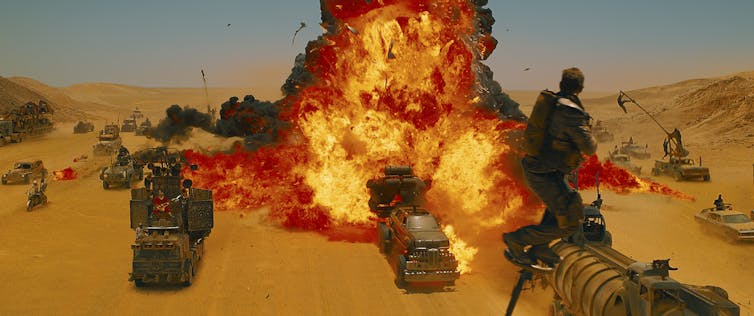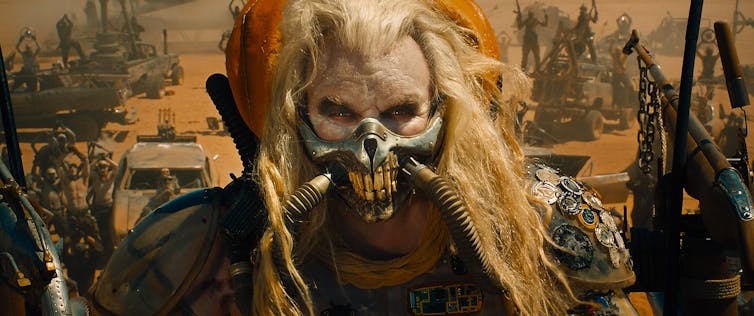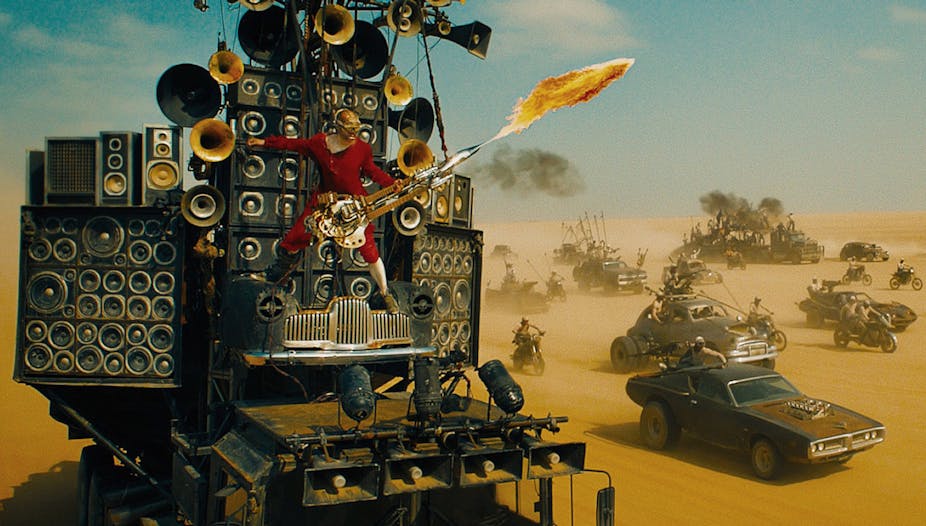Following the release of George Miller’s fourth Mad Max film Mad Max: Fury Road (2015), critics and audiences have been almost unanimous in their praise of the film’s flawless style, convincing world-making and insanely over the top – but also somehow just right – non-stop action sequences.
Behold the Doof Warrior
There has also been a noticeable groundswell of attention for one particular minor character: The Doof Warrior – aka, the guitar guy.
The Doof Warrior is a red-jumpsuited, masked guitarist, bungee-strapped to the front of the Doof Wagon, a massive, mobile speaker stack, replete with on-board drummers. The Doof Warrior is the equivalent of a marching band for the post-apocalyptic army-on-wheels that is pursuing Max.
His role is to shred out the soundtrack to the pursuit in real time, and occasionally shoot fire from the end of a double-headed axe.

Audience love for this undeniably awesome character ramped up even further as details about the film shoot circulated.
The Doof Wagon was, as reported, a fully-functional vehicle – including the amplifiers – and Australian musician iOTA, who plays the Doof Warrior, really did play (and shoot fire) as he was driven at high speeds through the desert.
This impressive realism is perfectly complemented by the soundtrack provided by electronic artist Junkie XL, who spent months perfecting the film’s sound in collaboration with Miller himself.

This combination of visual and aural aspects makes the Doof Warrior the focus of any scene he is in. It seems to make perfect sense, as well, in the Mad Max world, that of course you have a bungee guitarist riffing you to war.
But why does this seem so right?
What kind of man’s world is this?
Critics have been preoccupied with the gender politics of Fury Road.
Even before the release of the film, so-called “Men’s Rights Activists” were up in arms about the apparent focus on the female protagonist, Imperator Furiosa (played by Charlize Theron) instead of Max himself. As it transpires, the film goes far beyond just having a main female character.
The entire cast of the film is divided clearly along gender lines, and it is obvious that the men are the “bad guys”, while the women (and Max) are the ones we are supposed to be rooting for.
The use of masculine and feminine signifiers creates an unbridgeable divide between the two groups of characters. The women are nurturing, kind and selfless – and they display a suite of heroic values such as fearlessness, physical strength and resourcefulness.
This is most obvious in the rescued “brides” at the heart of the film (who represent an extreme version of femininity), but even the tougher Furiosa’s role is to strive and care for others.
The men, on the other hand, are portrayed as violent, cruel and selfish. The exception – the film’s hero, Max – is an outsider. Perhaps too much has been read into Max’s “diminished role” here. After all, he is something of a spectator and was a cajoled participant in the earlier films as well.
In Fury Road he is often placed into positions within the action narrative that are occupied by women, and he doesn’t seem to mind.

Guitar rock on Fury Road
The film’s vision of predatory, destructive hyper-masculinity is clearly conveyed through the culture of Immortan Joe – lord of The Citadel and the film’s primary antagonist – and his followers. They adhere to a warrior dogma and they’ve elevated car culture to a way of life. It is no coincidence that it’s an electric guitar that plays these men into battle.
The electric guitar has long been coded as a masculine instrument in western culture.
This is partly to do with its phallic nature – and the fiery emissions from the guitar in the movie encourage this reading. Too often, rock and roll is seen as “a man’s game”. Although it is no longer uncommon to see women playing electric guitars, this has taken decades to achieve, and female guitar heroes are still marginalised in the genre.
As such, it makes perfect sense that this is the instrument that takes such a prominent place in the film – it’s not just used, but venerated.
There’s a distinctly Australian accent to the film’s critique of hyper-masculinity. Fury Road speaks to car culture and good old Aussie pub rock.
Immortan’s horde resemble the disempowered, disenfranchised petrol-heads who are so maligned in Australian culture. Call them bogans, if you must.
Doing so introduces the element of class to a reading of the film. Miller is careful, however, to distinguish Immortan’s horde from the underclass he and his indoctrinated followers terrorise: they are the true battlers of Fury Road.
What we see onscreen is a gratuitous and spectacular representation of traditional Australian masculinities. Immortan’s men are clearly menacing and predatory – but they are also safely enshrined within an action movie narrative in which hypermasculinity is under threat.
At the same time, the playful, creative and outright fun elements of this culture are turned up to 11 and give the movie a large part of its appeal. This is perhaps why the Doof Warrior and his screaming solos become so easy to love, despite his association with the villains.
See also:
Frenzy on Fury Road: Mad Max faces a post-digital apocalypse
How Mad Max wrote the script for the action blockbuster

